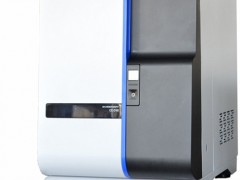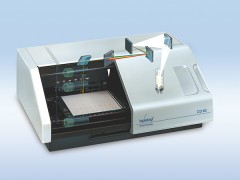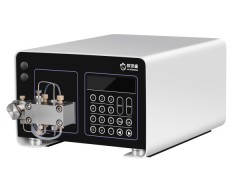里氏木霉是一种具有巨大蛋白分泌潜力的微生物,并且一直以来被认为是安全的工业生产菌株,在同源蛋白表达方面,该表达系统已满足工业生产的要求,且质量优异,产量巨大。但在异源蛋白表达方面,除仅有的数种异源蛋白表达量满足工业化生产外,该表达系统尚不足以进行工业化生产。随着近年来里氏木霉基因组学和蛋白组学的相关研究取得突飞猛进的发展,限制异源表达的瓶颈可能随时被打破,另一个类似于酵母表达系统稳定的异源蛋白表达系统即将产生。
本研究构建的里氏木霉外源基因表达载体 Ppth15,使用了里氏木霉zui强效的启动子 Pcbh1,并引入 CBH1 自身信号肽来介导目的蛋白的分泌性表达。通过引物设计,在 Pcbh1 上游引入 Sal I-Not I 2 个酶切位点,其目的是为后续实验,如启动子的替换、基因改造等预留空间;在启动子下游使用 Spe I-EcoR Ⅴ-Afl II 3 个常用酶切位点构成了多克隆位点,后续工作还可以在这个位点插入多种不同的酶切位点。根据坎贝尔机制,本实验使用里氏木霉 CBH1 的启动子 Pcbh1 与终止子 Tcbh1 形成两段同源性序列,以达到将目的基因表达框与里氏木霉 CBH1 表达框进行定向整合及替换的目的。
表达载体 Ppth15 上搭载了潮霉素磷酸转移酶基因 (HygB),启动 HygB 表达的是三磷酸甘油醛脱氢酶基因启动子(PgpdA),PgpdA 是组成型启动子,故当 HygB 整合入里氏木霉基因组后,它的翻译和表达不受培养基营养成分的影响,由此可使阳性转化子的筛选工作简单化。本实验成功地在里氏木霉中表达了绿色荧光蛋白,通过荧光显微镜可以清楚地观察到菌丝的顶端、隔膜及培养基中有大量荧光,这与丝状真菌胞外蛋白主要通过菌丝顶端分泌的论断一致。
但我们还发现一个有趣的现象,在横隔附近的细胞壁上,也可以看到有 eGFP 的堆积,分析原因可能是当横隔小孔转运 eGFP 的能力饱和后,造成 eGFP 的堆积,诱导宿主激活另一种蛋白分泌机制,同样的现象在黑曲霉表达中也有报道。通过对阳性菌株的发酵上清浓缩后进行 SDS-PAGE 分析,可以在预计大小位置观察到条带,这证明了绿色荧光蛋白被成功表达并分泌到了胞外。不可否认的是,在发酵液未经浓缩处理前,eGFP 的 SDS-PAGE 条带是不清晰的,说明表达量尚未达到zui大化、发酵条件也并非zui优。
后续实验可以在发酵条件、密码子优化,启动子修饰及选用蛋白酶缺陷菌株上进行综合优化、由此来提高外源蛋白的表达量。里氏木霉外源基因表达载体 Ppth15 的成功构建为进一步研究里氏木霉表达其他外源蛋白提供了有效的载体工具,绿色荧光蛋白的表达揭示了外源蛋白在里氏木霉中分泌的过程和特点,为里氏木霉高产工程菌株的培育提供了研究方向。
参 考 文 献
[1] 汪天虹, 吴静, 邹玉霞. 瑞氏木霉分子生物学研究进展 [J]. 菌物系统, 2000, 19(1): 147-152.
[2] Guangtao Z, Hartl L, Schuster A, et al. Gene targeting in a nonhomologous end joining deficient Hypocrea jecorina[J]. Journal of Biotechnology, 2009, 139(2): 146-151.
[3] Harkki A, Mantyla A, Penttila M, et al. Genetic engineering of Trichoderma to produce strains with novel cellulase profiles[J]. Enzyme and Microbial Technology, 1991, 13(3): 227-233.
[4] Durand H, Clanet M, Tiraby GER. Genetic improvement of Trichoderma reesei for large scale cellulase production[J]. Enzyme and Microbial Technology, 1988, 10(6): 341-346.
[5] Ward OP. Production of recombinant proteins by filamentous fungi[J]. Biotechnology Advances, 2012, 30(5): 1119-1139.
[6] Diener SE, Chellappan MK, Mitchell TK, et al. Insight into Trichoderma reesei s genome content, organization and evolution revealed through BAC library characterization[J]. Fungal Genetics and Biology, 2004, 41(12): 1077-1087.
[7] Salovuori I, Makarow M, Rauvala H, et al. Low molecular weight high-mannose type glycans in a secreted protein of the filamentous fungus Trichoderma reesei[J]. Nature Biotechnology, 1987, 5(2): 152-156.
[8] 钟耀华, 王晓利, 汪天虹. 丝状真菌表达异源蛋白研究进展[J]. 生物工程学报, 2008, 24(4): 531-540.
[9] Nevalainen KMH, TeʼO VSJ, Bergquist PL. Heterologous protein expression in filamentous fungi[J]. Trends in Biotechnology, 2005, 23(9): 468-474.
[10] van den Hombergh JP, van de Vondervoort PJ, Fraissinet-Tachet L, et al. Aspergillus as a host for heterologous protein production: the problem of proteases[J]. Trends in Biotechnology, 1997, 15(7): 256-263.
[11] Punt PJ, van Biezen N, Conesa A, et al. Filamentous fungi as cell factories for heterologous protein production[J]. Trends in Biotechnology, 2002, 20(5): 200-206.
[12] Wang LP, Ridgway D, Gu TY, et al. Bioprocessing strategies to improve heterologous protein production in filamentous fungal fermentations[J]. Biotechnology Advances, 2005, 23(2): 115-129.
[13] 刘倜. 多拷贝策略构建瑞氏木霉外源基因系列表达载体 [D]. 济南: 山东大学硕士学位论文, 2005, 58.
[14] TeʼO VSJ, Cziferszky AE, Bergquist PL, et al. Codon optimization of xylanase gene xynB from the thermophilic bacterium Dictyoglomus thermophilum for expression in the filamentous fungus Trichoderma reesei[J]. FEMS Microbiology Letters, 2000, 190(1): 13-19.
[15] 汪天虹, 刘倜, 刘世利, 等. 瑞氏木霉外源基因表达系统中受体菌株的改造 [J]. 菌物学报 , 2004, 23(2): 248-254.
[16] Zhong YH, Liu X, Xiao P, et al. expression and secretion of the human erythropoietin using an optimized cbh1 promoter and the native CBH I signal sequence in the industrial fungus Trichoderma reesei[J]. Applied Biochemistry and Biotechnology, 2011, 165(5/6): 1169-1177.
[17] Conesa A, Punt PJ, van Luijk N, et al. The secretion pathway in filamentous fungi: a biotechnological view[J]. Fungal Genetics and Biology, 2001, 33(3): 155-171.
[18] Shoji JY, Arioka M, Kitamoto K. Dissecting cellular components of the secretory pathway in filamentous fungi: insights into their application for protein production[J]. Biotechnology Letters, 2008, 30(1): 7-14.
[19] Valkonen M, Penttila M, Saloheimo M. The ire1 and ptc2 genes involved in the unfolded protein response pathway in the filamentous fungus Trichoderma reesei[J]. Molecular Genetics and Genomics, 2004, 272(4): 443-451.
[20] Saloheimo M, Lund M, Penttil AME. The protein disulphide isomerase gene of the fungus Trichoderma reesei is induced by endoplasmic reticulum stress and regulated by the carbon source[J]. Molecular and General Genetics MGG, 1999, 262(1): 34-45.
[21] Hampton RY. ER-associated degradation in protein quality control and cellular regulation[J]. Current Opinion in Cell Biology, 2002, 14(4): 476-482.
[22] Penttila M, Nevalainen H, Ratto M, et al. A versatile transformation system for the cellulolytic filamentous fungus Trichoderma reesei[J]. Gene, 1987, 61(2): 155-164.
[23] 郑红玉, 黄毓茂, 余希尧, 等. 黑曲霉分泌表达载体的构建以及绿色荧光蛋白的表达[J]. 华南农业大学学报, 2013, 34(4): 574-579.
[24] Vosman B, Kooistra J, Olijve J, et al. Integration of vector-containing Bacillus subtilis chromosomal DNA by a Campbell-like mechanism[J]. Molecular and General Genetics MGG, 1986, 204(3): 524-531.
[25] Gordon CL, Khalaj V, Ram AF, et al. Glucoamylase: green fluorescent protein fusions to monitor protein secretion in Aspergillus niger[J]. Microbiology, 2000, 146(Pt2): 415-426.
上一篇:细胞,该如何度过夏天呢? 下一篇:PD- 1细胞可抑制巨噬细胞吞噬功能返回列表 打印关闭*验证码: = 请输入计算结果(填写阿拉伯数字),如:三加四=7
 手机版|
手机版|

 二维码|
二维码|











